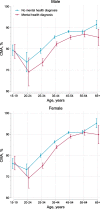Mental Health, ART Adherence, and Viral Suppression Among Adolescents and Adults Living with HIV in South Africa: A Cohort Study
- PMID: 36592251
- PMCID: PMC10149479
- DOI: 10.1007/s10461-022-03916-x
Mental Health, ART Adherence, and Viral Suppression Among Adolescents and Adults Living with HIV in South Africa: A Cohort Study
Abstract
We followed adolescents and adults living with HIV aged older than 15 years who enrolled in a South African private-sector HIV programme to examine adherence and viral non-suppression (viral load > 400 copies/mL) of participants with (20,743, 38%) and without (33,635, 62%) mental health diagnoses. Mental health diagnoses were associated with unfavourable adherence patterns. The risk of viral non-suppression was higher among patients with organic mental disorders [adjusted risk ratio (aRR) 1.55, 95% confidence interval (CI) 1.22-1.96], substance use disorders (aRR 1.53, 95% CI 1.19-1.97), serious mental disorders (aRR 1.30, 95% CI 1.09-1.54), and depression (aRR 1.19, 95% CI 1.10-1.28) when compared with patients without mental health diagnoses. The risk of viral non-suppression was also higher among males, adolescents (15-19 years), and young adults (20-24 years). Our study highlights the need for psychosocial interventions to improve HIV treatment outcomes-particularly of adolescents and young adults-and supports strengthening mental health services in HIV treatment programmes.
Monitoreamos adolescentes y adultos mayores de 15 años que viven con VIH y que están registrados en un programa privado Surafricano para el tratamiento del VIH. Nuestro propósito fue examinar adherencia a los medicamentos y supresión viral (carga viral < 400 copias/mL) en los participantes con (20,743, 38%) y sin (33,635, 62%) diagnósticos de salud mental. Los diagnósticos de salud mental estuvieron asociados con patrones de adherencia desfavorables. Comparados con pacientes sin diagnósticos de salud mental, el riesgo de no supresión viral fue más alto entre pacientes con desórdenes mentales orgánicos [riesgo relativo ajustado (aRR) 1.55, 95% intervalo de confidencia (CI) 1.22–1.96], desórdenes en el uso de sustancias (aRR 1.53, 95% CI 1.19–1.97), desórdenes mentales serios (aRR 1.30, 95% CI 1.09–1.54), y depresión (aRR 1.19, 95% CI 1.10–1.28). El riesgo de no supresión viral también fue más alto en hombres que en mujeres, en adolescentes (15–19 años), y en adultos jóvenes. Nuestro estudio resalta la necesidad de intervenciones psicosociales para mejorar los resultados del tratamiento contra el VIH –particularmente en adolescentes y adultos jóvenes—, y respalda el fortalecimiento de servicios de salud mental como parte de los programas para el tratamiento del VIH.
Keywords: Adherence; Antiretroviral therapy; HIV; Mental disorders; South Africa; Viral suppression.
© 2022. The Author(s).
Conflict of interest statement
The authors declare that they have no competing interests.
Figures



References
-
- Joint United Nations Programme on HIV/AIDS (UNAIDS). AIDSInfo online database. [Internet]. [cited 2022 Apr 10]. Available from: https://aidsinfo.unaids.org/.
-
- Ford N, Darder M, Spelman T, Maclean E, Mills E, Boulle A. Early adherence to antiretroviral medication as a predictor of long-term HIV virological suppression: five-year follow up of an observational cohort. Ndhlovu LC, editor. PLoS ONE. 2010;5(5):e10460. doi: 10.1371/journal.pone.0010460. - DOI - PMC - PubMed
MeSH terms
Substances
Grants and funding
LinkOut - more resources
Full Text Sources
Medical

